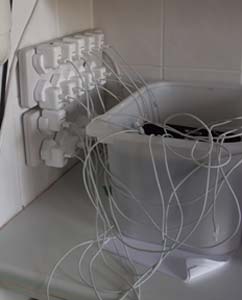
Cedars School of Excellence
As part of our literature review we visited a school that indicates how schools may operate in the future. Cedars School of Excellence in Greenock, Inverclyde, is an independent school that enrols to both primary and secondary pupils up to age 17. Cedars school is at the cutting edge, being one of the first schools in the world to provide an iPad for every enrolled pupil.
The decision to implement this technology was taken due to the teaching staff having a desire to implement more IT into their syllabus but finding it difficult to book usage time on the limited computers available within the school. A number of devices were suggested to increase IT capability including laptops, small handheld devices and tablets. Cedars school could not afford to provide enough laptops to meet the number of students enrolled. In the end the decision was taken to provide iPads to the pupils, as they were capable of utilising a vast array of apps, could connect to wireless and were good size to work alongside traditional paper.
The tablets are individually assigned and every pupil over 10 years old can take them home to do further study and homework. The school found that it has revolutionised the way they teach the children. Teachers spend less time lecturing or behind a desk and more time floating between clustered desks. The way students learn has changed as well by taking advantage of better technology. More self-motivated research is conducted.
The school leases the iPads from apple at £12 per pupil per month. Since purchase an optional scheme has been developed where parents pay monthly so that their can children own the device. One of the key advantages of using this technology is the ability to take advantage of the variety of apps. Applications are purchased from the App Store© and are distributed wirelessly to all pupils, ensuring everyone has the same software capability on their device.
Tablet technology is highly flexible, it can be applied effectively to most teaching contexts such as showing dangerous chemistry experiments safely on youtube or allowing work to be typed out using the on screen keyboard. In the past, money was spent on hardware devices to enhance the teaching environment; now it is possible to get an app with the same functionality for a fraction of the price.
“This is a device we bought, but it's not just a textbook or an instrument, or a set of art tools – it's all of those things and more” 1
We feel that the ability to supply data digitally will be important and have a larger impact in future schools. Cedars School is able to distribute learning materials such as textbooks and notes via a central server that will synchronise with the students’ iPads during the school day. The school puts an emphasis on having both hard and soft copies of work being carried out in class. Paper is used for rough notes, whereas the digital copy is for final submission.
We believe that the flexibility and functionality of these devices will make them a very attractive
 option to be adopted for schools in the future. In terms of energy demand for the school, Cedars reported that it was minimal. This is due to the low power consumption of the device and its long battery life. Students are encouraged to come in with the batteries fully charged, however Fraser Speirs, the head of IT at the school, says iPads make it through the day with 20%. Speirs remarked that the batteries:
option to be adopted for schools in the future. In terms of energy demand for the school, Cedars reported that it was minimal. This is due to the low power consumption of the device and its long battery life. Students are encouraged to come in with the batteries fully charged, however Fraser Speirs, the head of IT at the school, says iPads make it through the day with 20%. Speirs remarked that the batteries:
“[The iPad] ran and ran. I couldn't make the battery die, and I realised this alone would transform the technology experience in the classroom.” 1
If necessary, the school has charging stations in every room, which students can plug into. However, by allowing students to take the devices home students will nearly always have the iPads charged before the day begins at school.
1. http://www.techradar.com/news/computing/apple/the-school-that-gives-every-student-an-ipad-915539








